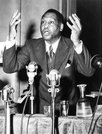 |
|
|
|
|
|
|
|

|
|

|
|

|
|

|
|

|
|

|
|

|
|

|
|

|
|

|
|

|
|

|
|

|
|

|
|

|
|
|
|
The audio programs on this site require RealPlayer.
Click the RealPlayer icon to download a free copy.
|
|
|
|
|
|
 |
 |
 |
|
|

|
|
Paul Robeson, addressing the
World Conference of Partisans
of Peace in Paris (1949).
|
|
|
|
|
American as Apple Pie
[1940—1954] |
|
|
|
Nationally broadcast during Black History Month, 2003, American as Apple Pie tells the story of the organizing drives and campaigns of the 1940s and early 1950s. Hear the voices of Paul Robeson, Thurgood Marshall, A. Phillip Randolph, Harry Truman, Esther Jackson, Stetson Kennedy and many others. How did the political struggle for civil rights take shape in trying to integrate the armed services and what would later be called “the military-industrial complex”? How did the the federal government shut down the KKK? What was Operation Dixie? Hear about the movement of African Americans into the newly industrialized workplace—and eventually into the U.S. mainstream.
|
|
|
|
|
|
|
|
|
|
>> CLICK THE SOUND ICON TO LISTEN TO THE CLIPS IN REALMEDIA
|
|
|
|
|
|
|
|
Sexual Terror and Racial Inequality. Time: 5:13
Racial and sexual inequalities were closely intertwined. Sexual use and abuse of black women by white men was as much a hallmark of the times as was the "strange fruit" of lynching black men under the pretext of punishing or controlling black male threats against white womanhood. The inequalities affected men and women, black and white alike—although not equally.
|

|
|
|
Black Integration Arrives on the National Stage. Time: 5:36
On the first day of 1940, millions thrilled to a nationwide radio broadcast, Ballad for Americans, in which Paul Robeson, African-American actor, singer and activist, lauded racial unity. President Roosevelt prepared the country for war, but refused to take a stand on integrating the armed forces. Black labor-leaders crafted a pressure-strategy to force equal treatment, including backstage meetings at the White House, and a national “March on Washington” movement.
|

|
|
|
Operation Dixie - Labor Hits the South. Time: 9:07
Industrial jobs drew millions of Americans from the countryside into urban centers like Richmond, Birmingham, and Atlanta. But in industry as in agriculture, Blacks' pay was low. And the threat of cheap black labor dragged down all workers' wages. The Congress of Industrial Organizations launched Operation Dixie to unionize the south, and tackle both economic exploitation and racial segregation.
|

|
|
|
Looking for Democracy;
Coming Home From the War. Time: 9:05
Some feared that with millions of African Americans in uniform, the War would be followed by an upsurge of racial violence. Experience in battle against fascism overseas did give them new expectations, and countless African American servicemen were attacked, sometimes killed, to deter them from thinking they were now equal to the white man
|

|
|
|
Speaking Truth to Terror. Time: 11:01
In the late 1940s, even with the President committed to the cause of African-Americans for the first time since the Civil War, many—especially in the South—still lived under a state of siege. Violent incidents led President Truman to take an interest in civil rights, beginning with integration of the Armed Forces. Civil Rights lawyer Thurgood Marshall went to Korea to investigate reports of trumped up charges against Black servicemen.
|

|
|
|
Anti-Communism and Building the Black Movement. Time: 6:47
Under McCarthyism and the anti-Communist crusades of the late 1940s and early 1950s, many African American and trade union organizers were silenced, jailed, and sometimes deported. The leaders of the civil rights and labor movements were forced to choose whether to face a similar fate by standing up to state and federal government attacks or quietly acquiesce to the purges in order to keep their organizations alive. The debate continues over what price was paid in the long term by the Civil Rights Movement.
|

|
|
|
|
|
|
|
|
|
|
|
HTML © 2003 Listening Between the Lines
|
|